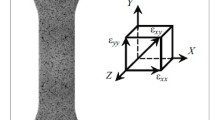Regular features of Luders strain due to appearance and propagation of one Chernov–Luders band (CLB) in superfine-grained steel 08G2B are investigated. Active, relaxation and peripheral zones are distinguished in the source of strain uniting the CLB nucleus; go-ahead-activated flow channels are defined. The functions of the zones are considered. Growth in the dislocation density and in the energy spent in the zones upon motion of the CLB front is evaluated. Mechanisms of appearance of new slip bands in the CLB and of unlocking of dislocations are analyzed.



Similar content being viewed by others
References
V. M. Farber, O. N. Polukhina, D. I. Vichuzhanin, et al., “A study of plastic strain before and on the yield plateau of steel 08G2B by the method of correlation of digital images. Part I. Formation of Plastic and Elastic Strain Waves,” Metalloved. Term. Obrab. Met., No. 5, 9 – 14 (2019).
S. Nagarajan and R. Narayanaswamy, “Study of local zones contributing to band growth associated with inhomogeneous plastic deformation,” Mater. Lett., 105, 209 – 212 (2003).
G. T. Van Rooyen, “The stress and strain distribution in a propagating Luders front accompanying the yield-point phenomenon in iron,” Mater. Sci. Eng., 3(2), 105 – 117 (1968).
M. A. Shtremel, Strength of Alloys. Pt. I. Lattice Defects [in Russian], MISiS, Moscow (1999), 384 p.
E. Gudremon, Special Steels, Vol. 1 [in Russian translation], GNTI, Moscow (1959), 952 p.
R. Honeycomb, Plastic Deformation of Metals [Russian translation], Mir, Moscow (1972), 408 p.
J. Hirth and J. Lohte, Theory of Dislocations [in Russian translation], Atomizdat, Moscow (1972).
V. M. Farber, I. Yu. Pyshmintsev, A. B. Arabey, et al., “Contribution of different structural factors into formation of properties of steels of strength class K65,” Izv. Vysh. Uchebn. Zaved., Chern. Metall., No. 9, 46 – 48 (2012).
The work has been performed at the UrFU with financial support of the Government of the Russian Federation (Act No. 211, Contract No. 02.A03.21.0006) and at the IMASh UrO RAN within the topic of State Provision No. 0391-2016-0004.
The tests have been conducted using the equipment of the Collective Use Center of the Ural Federal University and the “Plastometry” Collective Use Center of the IMASh UrO RAN.
Author information
Authors and Affiliations
Corresponding author
Additional information
Translated from Metallovedenie i Termicheskaya Obrabotka Metallov, No. 7, pp. 9 – 14, July, 2019
Rights and permissions
About this article
Cite this article
Farber, V.M., Polukhina, O.N., Vichuzhanin, D.I. et al. A Study of Plastic Strain Before and on the Yield Plateau of Steel 08G2B by Correlation of Digital Images. Part II. Functioning of Flow Channels and Zones in them. Met Sci Heat Treat 61, 405–410 (2019). https://doi.org/10.1007/s11041-019-00437-8
Published:
Issue Date:
DOI: https://doi.org/10.1007/s11041-019-00437-8




